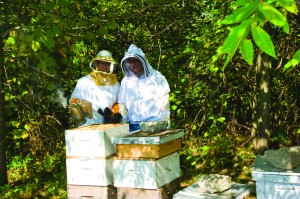For the Love of Honey
Toronto-based accountant Len Goldberg often tells friends and family that he runs a successful “sting operation.” A part-time apiarist for the past twenty-five years, Goldberg spends about two hours a week, from May through October, tending to the hives and the nearly quarter-million bees that he’s raised on a client’s property in Burlington, Ontario.
After harvesting the pure, organic honey that he and his wife Cheryl bottle as gifts for family and friends, Goldberg, who attends Shaarei Tefillah, an OU-member shul in Toronto, packs and insulates the hives for winter.
Goldberg harvests approximately five gallons of honey from three colonies. This year he has five colonies, so it looks like the Goldbergs will be busy bees come late August.
The harvesting of honey aptly corresponds with the onset of Rosh Hashanah. Each year Len and Cheryl transform their home into a hive of activity when they invite friends and family to gather in their kitchen on erev Rosh Hashanah to help with the honey distribution. Last year five volunteers helped with the process of spinning the honey in a hand-cranked centrifuge while others helped bottle and label each jar of honey. Goldberg never sells his honey; he always gives it away as gifts.
Cheryl and Len Goldberg harvest gallons of honey each year around Rosh Hashanah time to distribute to friends and family.
Cheryl uses some of the honey harvest to create delicious dishes for the chagim and throughout the year, including scrumptious Honey Garlic Chicken Wings (see recipe on p. 72).
Len started out in the bee business in 1987 when he took a beekeeping course at the University of Guelph. The following spring, he ordered several colonies of bees, each with a queen and 4,000 worker bees. He also set up a box and frame kit, beeswax and wire, which the bees would build into a hive.
Len recalls one of his first lessons as a beekeeper. “There was one thing the course didn’t teach us, and that was how to get the bees out of the box they come in and into the hive. You basically just dump the bees and run.”
Another early lesson was about the importance of the apiarist’s trusted coveralls and helmet. The first year, Goldberg made his own helmet. He was concerned that some bees had gotten inside and took off the helmet, leaving himself unprotected. “I had a swell time,” he says jokingly of the stings he endured.
It took Goldberg a while to get over his fears, but he was fascinated by what the bees were able to accomplish. “This insect, the size of a thumbnail, is able to work in partnership with tens of thousands of other bees to build the comb where the queen lays about 1,000 eggs per day, seal the hive with propolis, search and find pollen and nectar and communicate the location with the others. Bees keep the hive cool, feed the young, look after the queen and even arrange a replacement if she gets sick or stops laying eggs. To me, the entire process is a recurring miracle,” he says.
Goldberg often makes presentations at local schools about the wonders of beekeeping. “It’s always enjoyable to see how people react when they learn how hard the bees work,” he says. “Actually, bees are much like accountants at tax time.”
To hear an interview with beekeeper Len Goldberg, visit http://www.ou.org/life/inspiration/do-you-know-anyone-who-harvests-honey-stephen-savitsky/.
Norene Gilletz is a regular food writer for Jewish Action.

